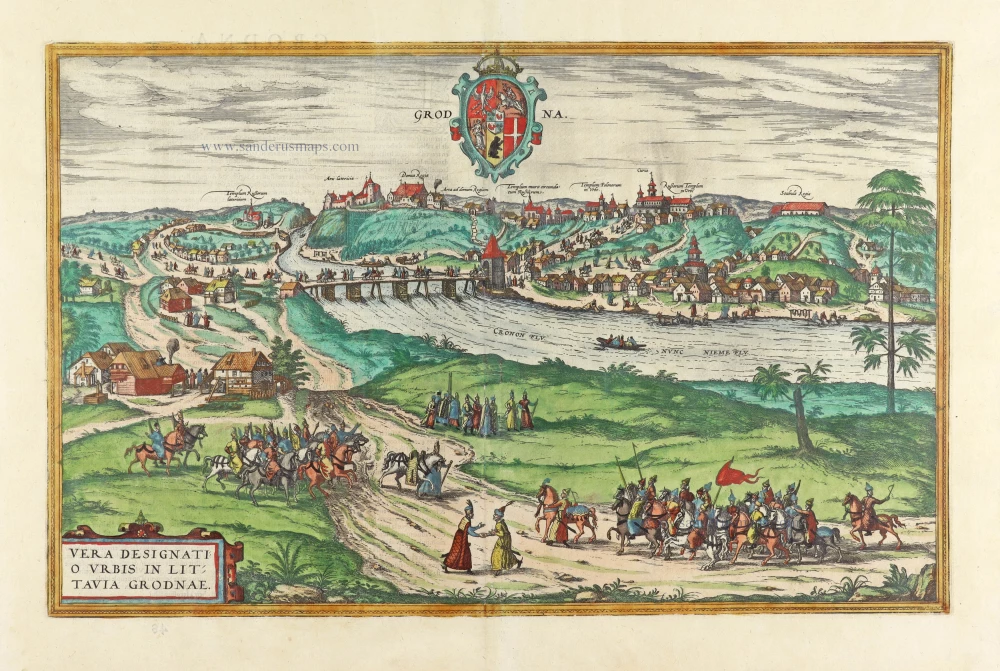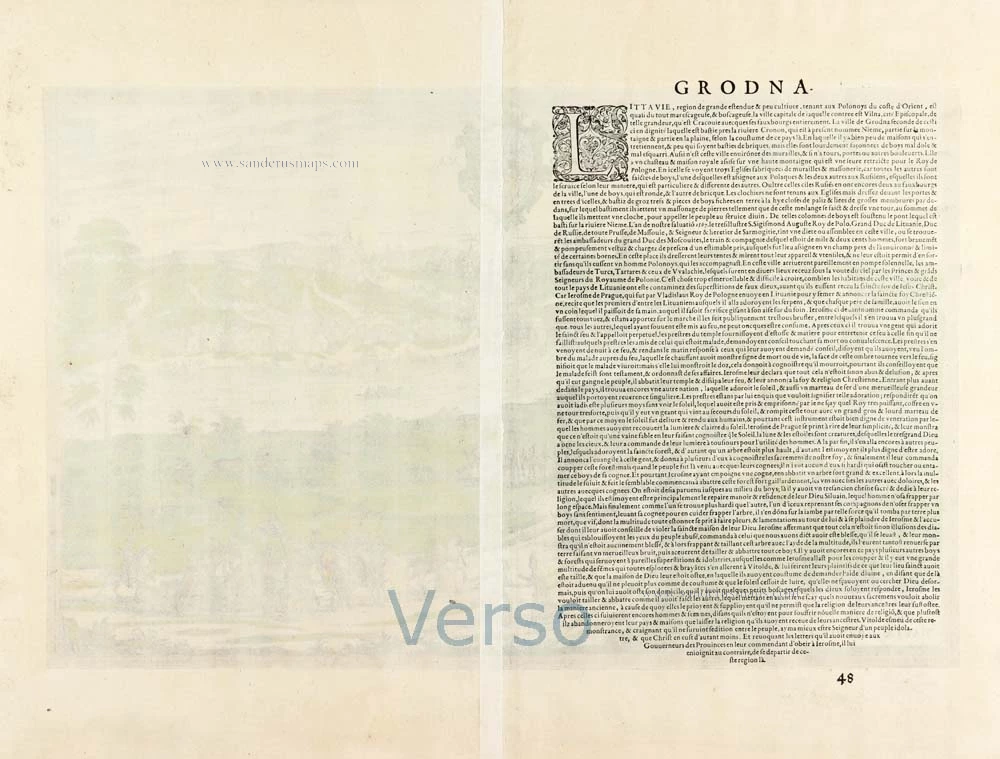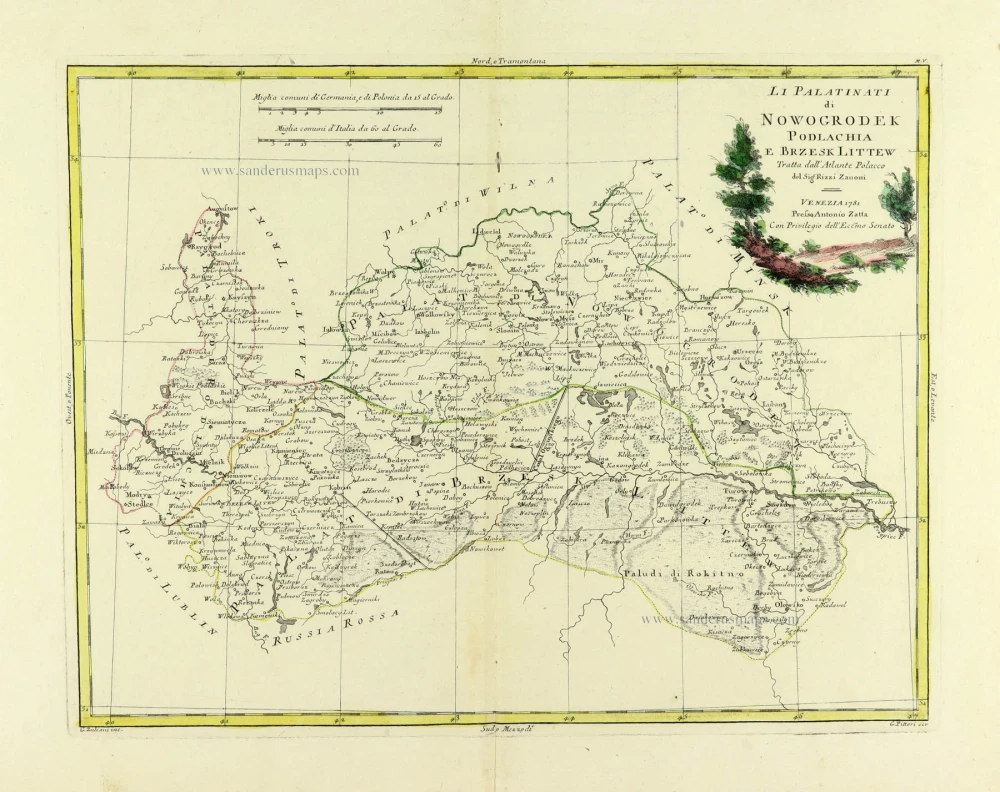View of Grodno (Belarus), by Braun and Hogenberg. 1693
TRANSLATION OF CARTOUCHE TEXT: Faithful picture of the city of Grodno in Lithuania.
COMMENTARY BY BRAUN: "Lithuania is a vast but uncultivated land, east of Poland, with much grassland and marshes. The episcopal city of Vilnius is the capital, and it is as big as Cracow with all its suburbs. The next biggest is Grodno, which lies on the River Cronon, or Memel, partly in the plain and partly on hilly ground. Only a few stone houses are standing together; the houses are roughly built with little care; the city also has no walls, towers, gates, or fortifications. But nearby, there is a castle and a royal palace on the mountain; the king of Poland has his seat there."
The engraving shows a view of the city from the far side of the Memel. Russian, Tatar, Turkish and Wallachian envoys crossed the wooden bridge and entered the city where King Sigismund II held an Imperial Diet in 1562. The earliest document in which Grodno is mentioned dates from 1128. In 1391, it was granted a municipal charter by Prince Vytautas, and it quickly rose to prosperity following the victory over the Teutonic Knights in the battle of Tannenberg in 1410; Orthodox (right) and Roman Catholic (left) churches were built, and three castles (left). Grodno, today known as Hrodna, has a population of 317,000, is the fifth-largest city in Belarus and shares a border with Lithuania and Poland.
The view is copied after an engraving by Matthias Zündt in 1568, after a drawing by Johann Adelhauser in 1567. (Taschen)
Braun G. & Hogenberg F. and the Civitates Orbis Terrarum.
The Civitates Orbis Terrarum, also known as the 'Braun & Hogenberg', is a six-volume town atlas and the most excellent book of town views and plans ever published: 363 engravings, sometimes beautifully coloured. It was one of the best-selling works in the last quarter of the 16th century. Georg Braun, a skilled writer, wrote the text accompanying the plans and views on the verso. Many plates were engraved after the original drawings of a professional artist, Joris Hoefnagel (1542-1600). The first volume was published in Latin in 1572 and the sixth in 1617. Frans Hogenberg, a talented engraver, created the tables for volumes I through IV, and Simon van den Neuwel made those for volumes V and VI. Other contributors were cartographers Daniel Freese and Heinrich Rantzau, who provided valuable geographical information. Works by Jacob van Deventer, Sebastian Münster, and Johannes Stumpf were also used as references. Translations appeared in German and French, making the atlas accessible to a broader audience.
Since its original publication of volume 1 in 1572, the Civitates Orbis Terrarum has left an indelible mark on the history of cartography. Seven more editions followed the first volume in 1575, 1577, 1582, 1588, 1593, 1599, and 1612. Vol.2, initially released in 1575, saw subsequent editions in 1597 and 1612. The subsequent volumes, each a treasure trove of historical insights, graced the world in 1581, 1588, 1593, 1599, and 1606. The German translation of the first volume, a testament to its widespread appeal, debuted in 1574, followed by the French edition in 1575.
Several printers were involved: Theodor Graminaeus, Heinrich von Aich, Gottfried von Kempen, Johannis Sinniger, Bertram Buchholtz, and Peter von Brachel, all of whom worked in Cologne.
Georg Braun (1541-1622)
Georg Braun, the author of the text accompanying the plans and views in the Civitates Orbis Terrarum, was born in Cologne in 1541. After his studies in Cologne, he entered the Jesuit Order as a novice, indicating his commitment to learning and intellectual pursuits. In 1561, he obtained his bachelor's degree; in 1562, he received his Magister Artium, further demonstrating his academic achievements. Although he left the Jesuit Order, he continued his studies in theology, gaining a licentiate in theology. His theological background likely influenced the content and tone of the text in the Civitates Orbis Terrarum, adding a unique perspective to the work.
Frans Hogenberg (1535-1590)
Frans Hogenberg was a Flemish and German painter, engraver, and mapmaker. He was born in Mechelen as the son of Nicolaas Hogenberg.
By the end of the 1560s, Frans Hogenberg was employed upon Abraham Ortelius's Theatrum Orbis Terrarum, published in 1570; he is named an engraver of numerous maps. In 1568, he was banned from Antwerp by the Duke of Alva and travelled to London, where he stayed a few years before emigrating to Cologne. He immediately embarked on his two most important works, the Civitates, published in 1572 and the Geschichtsblätter, which appeared in several series from 1569 until about 1587.
Thanks to large-scale projects like the Geschichtsblätter and the Civitates, Hogenberg's social circumstances improved with each passing year. He died as a wealthy man in Cologne in 1590.
Grodna - Vera Designatio Urbis in Littavia Grodnae.
Item Number: 30591 Authenticity Guarantee
Category: Antique maps > Europe > Eastern Europe
Bird's-eye view of Grodno (Belarus), by Braun and Hogenberg.
Title: Grodna - Vera Designatio Urbis in Littavia Grodnae.
Date of the first edition: 1575.
Date of this map: 1693.
Copper engraving, printed on paper.
Image size: 305 x 480mm (12.01 x 18.9 inches).
Sheet size: 415 x 535mm (16.34 x 21.06 inches).
Verso: French text.
Condition: Contemporary old coloured, excellent.
Condition Rating: A+.
From: Braun G. & Hogenberg F. Théatre des Cités du Monde. Premier Volume. Cologne, Gottfried von Kempen (?), c. 1593. (Van der Krogt 41:3.1)
TRANSLATION OF CARTOUCHE TEXT: Faithful picture of the city of Grodno in Lithuania.
COMMENTARY BY BRAUN: "Lithuania is a vast but uncultivated land, east of Poland, with much grassland and marshes. The episcopal city of Vilnius is the capital, and it is as big as Cracow with all its suburbs. The next biggest is Grodno, which lies on the River Cronon, or Memel, partly in the plain and partly on hilly ground. Only a few stone houses are standing together; the houses are roughly built with little care; the city also has no walls, towers, gates, or fortifications. But nearby, there is a castle and a royal palace on the mountain; the king of Poland has his seat there."
The engraving shows a view of the city from the far side of the Memel. Russian, Tatar, Turkish and Wallachian envoys crossed the wooden bridge and entered the city where King Sigismund II held an Imperial Diet in 1562. The earliest document in which Grodno is mentioned dates from 1128. In 1391, it was granted a municipal charter by Prince Vytautas, and it quickly rose to prosperity following the victory over the Teutonic Knights in the battle of Tannenberg in 1410; Orthodox (right) and Roman Catholic (left) churches were built, and three castles (left). Grodno, today known as Hrodna, has a population of 317,000, is the fifth-largest city in Belarus and shares a border with Lithuania and Poland.
The view is copied after an engraving by Matthias Zündt in 1568, after a drawing by Johann Adelhauser in 1567. (Taschen)
Braun G. & Hogenberg F. and the Civitates Orbis Terrarum.
The Civitates Orbis Terrarum, also known as the 'Braun & Hogenberg', is a six-volume town atlas and the most excellent book of town views and plans ever published: 363 engravings, sometimes beautifully coloured. It was one of the best-selling works in the last quarter of the 16th century. Georg Braun, a skilled writer, wrote the text accompanying the plans and views on the verso. Many plates were engraved after the original drawings of a professional artist, Joris Hoefnagel (1542-1600). The first volume was published in Latin in 1572 and the sixth in 1617. Frans Hogenberg, a talented engraver, created the tables for volumes I through IV, and Simon van den Neuwel made those for volumes V and VI. Other contributors were cartographers Daniel Freese and Heinrich Rantzau, who provided valuable geographical information. Works by Jacob van Deventer, Sebastian Münster, and Johannes Stumpf were also used as references. Translations appeared in German and French, making the atlas accessible to a broader audience.
Since its original publication of volume 1 in 1572, the Civitates Orbis Terrarum has left an indelible mark on the history of cartography. Seven more editions followed the first volume in 1575, 1577, 1582, 1588, 1593, 1599, and 1612. Vol.2, initially released in 1575, saw subsequent editions in 1597 and 1612. The subsequent volumes, each a treasure trove of historical insights, graced the world in 1581, 1588, 1593, 1599, and 1606. The German translation of the first volume, a testament to its widespread appeal, debuted in 1574, followed by the French edition in 1575.
Several printers were involved: Theodor Graminaeus, Heinrich von Aich, Gottfried von Kempen, Johannis Sinniger, Bertram Buchholtz, and Peter von Brachel, all of whom worked in Cologne.
Georg Braun (1541-1622)
Georg Braun, the author of the text accompanying the plans and views in the Civitates Orbis Terrarum, was born in Cologne in 1541. After his studies in Cologne, he entered the Jesuit Order as a novice, indicating his commitment to learning and intellectual pursuits. In 1561, he obtained his bachelor's degree; in 1562, he received his Magister Artium, further demonstrating his academic achievements. Although he left the Jesuit Order, he continued his studies in theology, gaining a licentiate in theology. His theological background likely influenced the content and tone of the text in the Civitates Orbis Terrarum, adding a unique perspective to the work.
Frans Hogenberg (1535-1590)
Frans Hogenberg was a Flemish and German painter, engraver, and mapmaker. He was born in Mechelen as the son of Nicolaas Hogenberg.
By the end of the 1560s, Frans Hogenberg was employed upon Abraham Ortelius's Theatrum Orbis Terrarum, published in 1570; he is named an engraver of numerous maps. In 1568, he was banned from Antwerp by the Duke of Alva and travelled to London, where he stayed a few years before emigrating to Cologne. He immediately embarked on his two most important works, the Civitates, published in 1572 and the Geschichtsblätter, which appeared in several series from 1569 until about 1587.
Thanks to large-scale projects like the Geschichtsblätter and the Civitates, Hogenberg's social circumstances improved with each passing year. He died as a wealthy man in Cologne in 1590.






